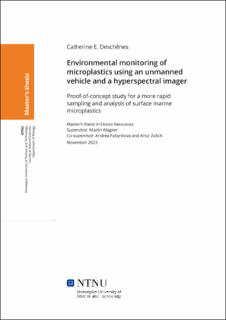| dc.description.abstract | Marine plastics pollution is an urgent environmental matter. Understanding the transport and effects of plastics over long spatial and temporal scales must be a priority in environmental monitoring. Challenges from current methods have been addressed, including inadequate representation of real abundance, incompatibil- ity between results, the necessity of a vessel for sampling, and time-consuming analysis.
This proof-of-concept study aimed to improve the sampling and analysis of microplastics (MPs) by combining a portable catamaran device (PCD) and a near- infrared hyperspectral imager (HSI). The PCD robot collected 35 samples over 4 days at two different locations around Runde, a bird-protected island on the Western coast of Norway - one location exposed to dominant current and wind, and the other protected. An HSI was used to increase sample analysis throughput and reduce time and costs. Environmental comparison of HSI was done using an attenuated total reflection Fourier transform infrared (ATR-FTIR).
We observed net advantages when using a robot combined with HSI, includ- ing increased accessibility, selectivity, scalability, and repeatability. HSI detected (> 300 μm) a significantly lower polypropylene (PP) concentration and a higher polyethylene (PE) concentration compared to ATR-FTIR. Higher abundance in a smaller size range was observed in both datasets. Overall, both HSI and FTIR methods effectively captured variations in MPs concentrations during the field campaign, with a mean of 0.09 MPs/m3, supporting the validity of HSI for detec- tion. Significant variations of MPs concentrations between locations were observed with the HSI. At the exposed location, we observed the highest concentration and variation of MPs ranging from 0 to 0.79 MPs/m3. A positive correlation with wind speed likely explains the variations whereas tide levels were not correlated. Sam- pling over multiple days showed a significant difference in the medians between the days.
We conclude that sporadic MPs presence at Runde underscores the need for in- creased sampling frequency and addresses comparability limitations between stud- ies. PCD and HSI can enable an easy repeatable sampling and analysis method for higher spatial and temporal variability to move towards a reproducible analytical pipeline for future MPs monitoring programs and understand better correlation between environmental factors and MPs concentration. | |
